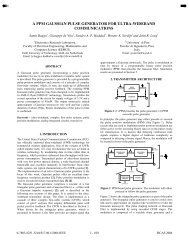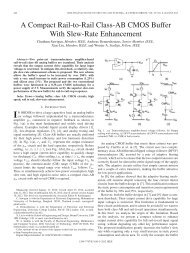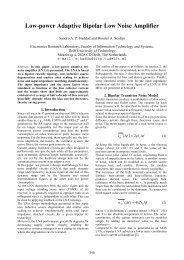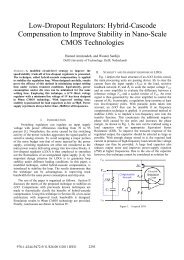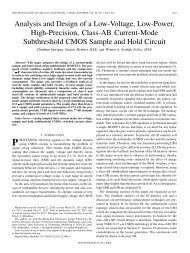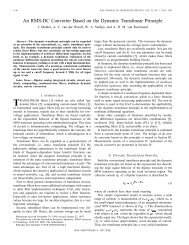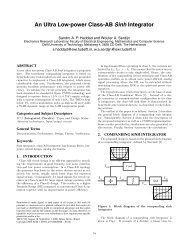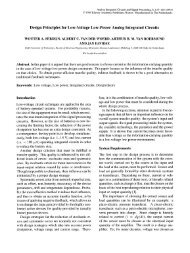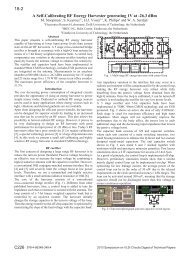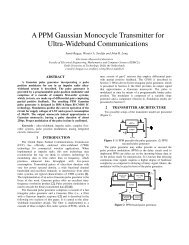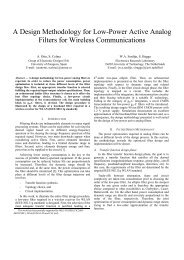Surpassing Bessel-Thomson by Pade ... - ResearchGate
Surpassing Bessel-Thomson by Pade ... - ResearchGate
Surpassing Bessel-Thomson by Pade ... - ResearchGate
Create successful ePaper yourself
Turn your PDF publications into a flip-book with our unique Google optimized e-Paper software.
High-Performance Analog Delays:<br />
<strong>Surpassing</strong> <strong>Bessel</strong>-<strong>Thomson</strong> <strong>by</strong> Padé-approximated Gaussians<br />
Sayyed Mahdi Kashmiri, Sandro A. P. Haddad, Wouter A. Serdijn<br />
Electronics Research Laboratory, Faculty of Electrical Engineering, Mathematics and Comp. Science<br />
Delft University of Technology, Mekelweg 4, 2628 CD Delft, the Netherlands<br />
Emails: [s.m.kashmiri, s.haddad, w.a.serdijn]@ewi.tudelft.nl<br />
Abstract—The frequency-domain exponential transfer function of a<br />
delay function cannot be realized with a finite number of lumped<br />
elements. Therefore an approximation of a rational quotient of<br />
polynomials has to be used. While the use of <strong>Bessel</strong> polynomials<br />
results in the well-known all-pole <strong>Bessel</strong>-<strong>Thomson</strong> approximation, a<br />
Taylor expansion of the exponential transfer function of a delay<br />
around one point results in another type of rational transfer, known<br />
as Padé approximation. Although a <strong>Bessel</strong>-<strong>Thomson</strong> approximation<br />
results in an overshoot-free step response it has slower response and<br />
smaller bandwidth in comparison to a Padé-approximated delay.<br />
Unfortunately, the latter suffers from overshoot. To reduce the<br />
overshoot but preserve the fast-response and large-bandwidth<br />
properties, a new delay approximation method is introduced. The<br />
method is based on approximation of the delta time-domain<br />
response of an ideal delay <strong>by</strong> a narrow Gaussian time-domain<br />
impulse response. The subsequent Padé approximation of the<br />
corresponding Gaussian transfer function yields a rational transfer<br />
function that is ready for implementation in an analog fashion and<br />
realizes a delay with both a large bandwidth and little overshoot.<br />
Index Terms—Delay Filters, <strong>Bessel</strong>-<strong>Thomson</strong> Approximation, Padé<br />
Approximation, Magnitude/Phase Response, Stability, Step<br />
Response, Rise Time.<br />
I. INTRODUCTION<br />
delay is a fundamental block in signal-processing systems.<br />
A Pure delays should ideally not change the magnitude or<br />
shape of the input signal. Considering a fixed delay of τ, its<br />
frequency-domain transfer function is defined <strong>by</strong> the exponential<br />
H(s)=exp(-τs), which cannot be realized with a finite number of<br />
lumped elements [1]. The best solution is an approximation with<br />
a rational quotient of polynomials: G(s)=N(s)/D(s). One common<br />
approach to approximate a delay transfer function is through the<br />
use of <strong>Bessel</strong> polynomials leading to an all-pole filter<br />
approximation called <strong>Bessel</strong>-<strong>Thomson</strong> realization. Another<br />
approximation yielding a rational expression suitable for<br />
implementation through the use of a Taylor expansion of the<br />
frequency-domain non-rational transfer function around one<br />
point is called the Padé approximation. By narrowing of a<br />
Gaussian impulse-response function with the use of smaller<br />
pulse width σ, the delta time-domain impulse response of a delay<br />
is approximated as a third method in this work. The new delayapproximation<br />
method is completed through the application of a<br />
Padé approximation on the Laplace transform of the Gaussian<br />
function. The performance of these different approximations of a<br />
delay filter has been systematically compared, in regard to<br />
achievable cut-off frequency and time-domain characteristics. It<br />
was revealed that our Gaussian approximation of the time<br />
domain transfer function decreased overshoot in the step<br />
response, while keeping the other characteristics fixed.<br />
This paper has six sections. Section II briefly recapitulates the<br />
mostly used <strong>Bessel</strong>-<strong>Thomson</strong> delay-filter approximation method.<br />
Padé approximation is introduced in section III, and a systemlevel<br />
overview of the delay-filter performance is investigated in<br />
this section. A systematic simulation of both methods using<br />
MATLAB ® is illustrated in section IV. The proposed method of<br />
narrow Gaussian time-domain impulse response is discussed,<br />
simulated, and compared to the other two methods in section V.<br />
A conclusion of the derived results can be found in section VI.<br />
II. BESSEL-THOMSON APPROXIMATION<br />
<strong>Bessel</strong> <strong>Thomson</strong> is the most widely used approximation method<br />
of delay filters. This method leads to a family of low-pass allpole<br />
transfer functions T(s), which would give approximately<br />
constant time delay over as large frequency range as possible.<br />
The resultant transfer functions are of the form [1]:<br />
B0<br />
( s)<br />
1<br />
Tn<br />
( s)<br />
= =<br />
(1)<br />
2<br />
B ( s)<br />
(2n<br />
−1)<br />
⋅ B ( s)<br />
+ s ⋅ B ( s)<br />
n<br />
n−1<br />
n−2<br />
where B n<br />
(s)<br />
is the general <strong>Bessel</strong> polynomial of order n with<br />
B<br />
0<br />
( s)<br />
= 1 and B<br />
1<br />
( s)<br />
= s + 1. In this approximation, the only<br />
degree of freedom available is the filter order, determined <strong>by</strong> the<br />
number of poles. A frequency-domain analysis of these filters<br />
illustrates a low-frequency behavior in which the roll-off<br />
frequencies are increased <strong>by</strong> filter-order increase. Fig.1<br />
illustrates the correspondent amplitude and delay responses of<br />
<strong>Bessel</strong>-<strong>Thomson</strong> filters of order 1 to 12.<br />
Amplitude<br />
1<br />
0.9<br />
0.8<br />
0.7<br />
0.6<br />
0.5<br />
0.4<br />
0.3<br />
0.2<br />
0.1<br />
0<br />
10 -1 10 0 10 1<br />
Frequency rad/Sec (Normalized)<br />
Delay<br />
0.012<br />
0.01<br />
0.008<br />
0.006<br />
0.004<br />
0.002<br />
0<br />
10 -2 10 -1 10 0 10 1 10 2<br />
Frequency rad/Sec (Normalized)<br />
(a)<br />
(b)<br />
Fig. 1. (a) <strong>Bessel</strong>-<strong>Thomson</strong> filter amplitude responses for orders 1 to 12 (b)<br />
Phase responses of the same filters<br />
Fig. 2 illustrates the step responses of different orders of<br />
<strong>Bessel</strong>-<strong>Thomson</strong> delay filters. The most important characteristic<br />
of the <strong>Bessel</strong>-<strong>Thomson</strong> filter, which is an overshoot-free step<br />
0-7803-9390-2/06/$20.00 ©2006 IEEE<br />
2349 ISCAS 2006
esponse, in addition to the resultant decrease of rise time due to<br />
filter-order increase can also be viewed here.<br />
Amplitude<br />
1.4<br />
1.2<br />
1<br />
Step Response<br />
0.8<br />
N=1<br />
N=2<br />
0.6<br />
N=3<br />
N=4<br />
N=5<br />
0.4<br />
N=6<br />
N=7<br />
N=8<br />
N=9<br />
0.2<br />
N=10<br />
N=11<br />
N=12<br />
0<br />
0 0.5 1 1.5 2 2.5 3 3.5<br />
Time (s)<br />
Fig. 2. Step response of different order <strong>Bessel</strong>-<strong>Thomson</strong> filters.<br />
III. PADÉ APPROXIMATION<br />
Padé approximation is a method of approximating a rational<br />
transfer function <strong>by</strong> expanding a function as a ratio of two power<br />
series [2]. The Padé approximation of order [m,n] for a function<br />
A(s) is defined to be a rational function H m,n (s) expressed in a<br />
fractional form:<br />
Pm<br />
( s)<br />
Hm , n(<br />
s)<br />
= (2)<br />
Q ( s)<br />
where P m (s) and Q n (s) are two polynomials as below:<br />
n<br />
2<br />
m<br />
Pm<br />
( s)<br />
= p0 + p1s<br />
+ p2s<br />
+ ... + pms<br />
(3)<br />
2 n<br />
Qn<br />
( s)<br />
= q0<br />
+ q1s<br />
+ q2s<br />
+ ... + qns<br />
The unknown coefficients p 0 ... p m and q 0 ... q n of H m,n (s) can<br />
be determined from the condition that the first (m+n+1) terms<br />
vanish in the Maclaurin series [2]:<br />
P ( s)<br />
A( s)<br />
− m = 0<br />
(4)<br />
Qn<br />
( s)<br />
Substituting the two polynomials into this expression and<br />
equating the coefficients leads to a system of m+n+1 linear<br />
homogeneous equations, which can be expressed in matrix form<br />
[2],[3].<br />
One of the main advantages of the Padé approximation is that<br />
the linear system of equations yields a unique solution, which is<br />
generically easy to compute. Moreover, a good match is<br />
guaranteed between the given function in time and its<br />
approximation H(s) in a neighborhood of the selected point s 0 .<br />
However, the selection of the expansion point s 0 is a trade-off<br />
between stability and a good fit around s=s 0 in the time domain.<br />
[4]. In this respect, the Padé approximation used here was<br />
obtained choosing s 0 = 0, which corresponds to a good fit in the<br />
time domain for large values of t.<br />
Furthermore, the selection of the orders m and n is not a<br />
straightforward task. An unlucky choice may yield an<br />
inconsistent system or an unstable approximation. Nevertheless,<br />
this is not an important issue, because one can easily solve this<br />
problem <strong>by</strong> changing the value of m, for a certain n-th order<br />
approximation, as one can deduce from the discussion that<br />
follows.<br />
Fig. 3 illustrates that in a Padé-approximated delay filter, for<br />
an increase of denominator order, the 3-dB cut off frequency of<br />
amplitude response increases, while peaking occurs for increase<br />
of order difference between numerator and denominator.<br />
Amplitude<br />
1.4<br />
1.2<br />
1<br />
0.8<br />
0.6<br />
0.4<br />
0.2<br />
The amplitude of <strong>Pade</strong> Approximated Delay Filters<br />
0<br />
10 0 10 1<br />
Frequency rad/Sec (Normalized)<br />
m=4, n=9<br />
m=4, n=8<br />
m=4, n=7<br />
m=4, n=6<br />
m=4, n=5<br />
Fig.3. Amplitude responses of Padé-approximated delay filters with m=4 and n=<br />
5...9<br />
A delay-response simulation of Padé-approximated delay<br />
filters for different order differences between numerator and<br />
denominator order (n-m), while increasing the denominator order<br />
(n) from 5 to 12 is illustrated in Fig. 4. This figure illustrates that<br />
for higher denominator order, higher delay roll-off frequency is<br />
achieved, while the peaking effect near the roll-off frequency<br />
increases for higher numerator and denominator order<br />
differences. More accurate delay response is achieved for smaller<br />
order difference and higher denominator order.<br />
Delay<br />
0.2<br />
0.18<br />
0.16<br />
0.14<br />
0.12<br />
0.1<br />
0.08<br />
0.06<br />
0.04<br />
0.02<br />
The Delay of <strong>Pade</strong> Approximated Delay Filters<br />
Increase of Order<br />
n = 5 ~ 12<br />
n-m = 4<br />
n-m = 3<br />
n-m = 2<br />
n-m = 1<br />
n-m = 0<br />
0<br />
0 5 10 15 20 25 30<br />
Frequency rad/Sec (Normalized)<br />
Fig.4. Delay response of Padé-approximated delay for different order difference<br />
and different denominator order.<br />
A series of time-domain simulations on the step response of<br />
Padé-approximated delay filters illustrates that the rise time<br />
decreases with the increase of the denominator order (Fig. 5),<br />
while zero-time oscillations are generated when the order<br />
difference between the denominator and numerator decreases.<br />
These zero-time oscillations are not favorable and might cause<br />
instability in some applications.<br />
2350
Step Response<br />
Time (sec)<br />
1.2<br />
Step Response<br />
0.012<br />
The Delay of <strong>Pade</strong> 6/8 Approximated Delay vs. 8th Order <strong>Bessel</strong> <strong>Thomson</strong><br />
1<br />
<strong>Pade</strong> 4/6<br />
0.01<br />
0.8<br />
<strong>Pade</strong> 10/12<br />
Amplitude<br />
0.6<br />
.<br />
0.4<br />
0.008<br />
0.2<br />
0<br />
m=2, n=5<br />
m=3, n=6<br />
m=4, n=7<br />
m=5, n=8<br />
m=6, n=9<br />
Delay<br />
0.006<br />
0.004<br />
-0.2<br />
0 0.5 1 Time 1.5 (sec) 2 2.5 3<br />
Fig.5. Rise-time decrease with filter order increase<br />
0.002<br />
<strong>Bessel</strong> <strong>Thomson</strong> 4<br />
<strong>Bessel</strong> <strong>Thomson</strong> 12<br />
Fig. 6 illustrates that the filter order increase results in a faster<br />
step response while filters with larger numerator and<br />
denominator order difference provide smaller rise times.<br />
rise time (Seconds)<br />
0.35<br />
0.3<br />
0.25<br />
0.2<br />
The rise time of <strong>Pade</strong> Approximated delay filters<br />
n=m+3<br />
n=m+2<br />
n=m+1<br />
0<br />
0 5 10 15 20 25 30<br />
Frequency rad/Sec (Normalized)<br />
Fig.8. Delay comparison of <strong>Bessel</strong>-<strong>Thomson</strong> delay filters of orders 4 to 12 vs.<br />
Padé-approximated delay filters of order 4/6 to 10/12.<br />
A comparison of step responses of both approximations (Fig.<br />
9) illustrates that Padé-approximated delay filters always<br />
introduce more overshoot and oscillations in comparison to<br />
<strong>Bessel</strong>-<strong>Thomson</strong> counterparts, while the former has smaller rise<br />
times (Fig. 10).<br />
0.15<br />
1.2<br />
1<br />
Step response<br />
<strong>Pade</strong> 6/8<br />
<strong>Bessel</strong> 8<br />
0.1<br />
4 5 6 7 8 9 10 11 12<br />
m (numinator order)<br />
0.8<br />
Fig.6. Rise-time comparison for different combinations of numerator and<br />
denominator orders.<br />
Amplitude<br />
0.6<br />
0.4<br />
IV. COMPARISON OF BESSEL-THOMSON AND PADÉ-<br />
APPROXIMATED DELAY FILTERS<br />
In this section a comparison of the frequency-domain and timedomain<br />
performance metrics of <strong>Bessel</strong>-<strong>Thomson</strong> and Padéapproximated<br />
delay filters are illustrated. According to amplitude<br />
and delay responses sketched for different order combinations of<br />
<strong>Bessel</strong>-<strong>Thomson</strong> and Padé delay filters, in Fig. 7 and Fig. 8<br />
respectively, the lower orders of Padé approximation can always<br />
achieve higher frequencies than the highest reasonable <strong>Bessel</strong>-<br />
<strong>Thomson</strong> approximations.<br />
1.4<br />
Comparison of The amplitude of <strong>Pade</strong> Delay Filters and <strong>Bessel</strong> <strong>Thomson</strong> Delay Filters<br />
0.2<br />
0<br />
-0.2<br />
0 0.5 1 1.5 2 2.5 3 3.5 4<br />
Time (sec)<br />
Fig.9. Comparison of step response in both approximations<br />
rise time (Seconds)<br />
1.1<br />
1<br />
0.9<br />
0.8<br />
0.7<br />
0.6<br />
0.5<br />
The rise time of <strong>Pade</strong> and <strong>Bessel</strong> Approximated delay filters<br />
<strong>Pade</strong> m, n=m+3<br />
<strong>Pade</strong> m, n=m+2<br />
<strong>Pade</strong> m, n=m+1<br />
<strong>Bessel</strong> <strong>Thomson</strong> order m<br />
1.2<br />
1<br />
<strong>Bessel</strong> <strong>Thomson</strong> 12<br />
<strong>Pade</strong> 2/4<br />
0.4<br />
0.3<br />
0.2<br />
0.1<br />
4 5 6 7 8 9 10 11 12<br />
m (numinator order)<br />
Amplitude<br />
0.8<br />
0.6<br />
0.4<br />
0.2<br />
<strong>Pade</strong> 10/12<br />
Fig.10. Rise time comparison<br />
In order to have the higher frequency and faster time-domain<br />
response of Padé approximation, together with less overshoots as<br />
the <strong>Bessel</strong>-<strong>Thomson</strong> approximation achieves, a new<br />
approximation method is introduced in the following section.<br />
<strong>Bessel</strong> <strong>Thomson</strong> 4<br />
0<br />
0 5 10 15 20 25 30<br />
Frequency rad/Sec (Normalized)<br />
Fig.7. Amplitude comparison of <strong>Bessel</strong>-<strong>Thomson</strong> delay filters of orders 4 to 12<br />
vs. Padé approximated delay filters of order 2/4 to 10/12.<br />
V. GAUSSIAN TIME-DOMAIN IMPULSE-RESPONSE METHOD<br />
The time-domain impulse response of a delay function is a delta<br />
function. A delta function can be approximated <strong>by</strong> narrowing of<br />
a Gaussian time-domain transfer function with the use of smaller<br />
pulse width σ, as illustrated <strong>by</strong> Equation 5 and Fig. 11.<br />
2351
0.6 0.7 0.8 0.9 1 1.1 1.2 1.3<br />
40<br />
35<br />
30<br />
25<br />
20<br />
15<br />
10<br />
5<br />
0<br />
Sigma=0.01<br />
Mean = 1<br />
Sigma=0.1<br />
Fig.11. A Gaussian function’s response vs. the change of σ<br />
2<br />
−(<br />
t −μ)<br />
1<br />
2<br />
h( t)<br />
= e 2σ<br />
(5)<br />
σ 2π<br />
In this method a Padé approximation is applied to the<br />
Laplace transform of a Gaussian impulse response [3]. Figure 12<br />
illustrates that the amplitude response of the Gaussian impulseresponse<br />
delay filter becomes closer to the response when using<br />
a <strong>Bessel</strong>-<strong>Thomson</strong> approximation for larger values of σ,<br />
decreasing the roll-off frequency, while Fig. 13 illustrates that<br />
the effect on the delay response is minimum.<br />
An investigation of the Gaussian impulse-response delay<br />
filter’s step response proves that the increase of σ, making the<br />
impulse response wider, leads to a decrease of the zero-time<br />
oscillations and overshoots, while it hardly increases the rise<br />
time. It is revealed that using a time-domain Gaussian impulse<br />
response gives the possibility of decreasing the overshoots and<br />
zero-time ringings in a Padé approximation of delay <strong>by</strong><br />
increasing σ, while the price paid is an increase of insertion loss<br />
in the amplitude response and a slightly slower rise time in the<br />
system step response.<br />
Fig. 14 compares the step response of a 6/8 Padéapproximated<br />
delay filter with the same order Gaussian impulse<br />
response delay filter with σ value equal to 0.05. As illustrated <strong>by</strong><br />
this graph, for the same nominator and denominator order, the<br />
Gaussian impulse response delay has less overshoot.<br />
1.2<br />
1<br />
0.8<br />
0.6<br />
0.4<br />
<strong>Pade</strong> approximation<br />
Gaussian Impulse response approximation<br />
Sigma = 0.05<br />
1.4<br />
Comparison of The amplitude of <strong>Pade</strong> Delay Filter of order 6/8 and a <strong>Bessel</strong> <strong>Thomson</strong> of order 8<br />
0.2<br />
0<br />
1.2<br />
<strong>Pade</strong> of Delay order 8/10<br />
-0.2<br />
0 0.5 1 1.5 2 2.5 3 3.5 4 4.5 5<br />
Amplitude<br />
1<br />
0.8<br />
0.6<br />
0.4<br />
0.2<br />
<strong>Bessel</strong> <strong>Thomson</strong> order 32<br />
<strong>Bessel</strong> <strong>Thomson</strong> order 10<br />
<strong>Pade</strong> of Gaussian order 8/10, sigma=0.01<br />
<strong>Pade</strong> of Gaussian order 8/10, sigma=0.1<br />
0<br />
0 5 10 15 20 25 30<br />
Frequency rad/Sec (Normalized)<br />
Fig.12. The amplitude response of the Gaussian impulse-response delay vs. σ in<br />
comparison to normal Padé-approximated delay and <strong>Bessel</strong>-<strong>Thomson</strong> responses<br />
Fig.15. The step response of a Gaussian impulse-response delay for a value of σ =<br />
0.05 vs. a Padé-approximated delay filter of the same (6/8) filter order.<br />
VI. CONCLUSIONS<br />
While <strong>Bessel</strong> <strong>Thomson</strong> is the most widely used method of delayfilter<br />
approximation, higher frequency and faster delay responses<br />
can be achieved through the use of Padé approximation at the<br />
expense of more overshoot. The here introduced method of<br />
Gaussian time-domain impulse response produces a rational<br />
transfer function that is ready for implementation in an analog<br />
fashion and realizes a delay with both a large bandwidth and<br />
little overshoot.<br />
0.012<br />
0.01<br />
0.008<br />
The Delay of <strong>Pade</strong> Approximated Delay vs. 8th Order <strong>Bessel</strong> <strong>Thomson</strong>, and Gaussian <strong>Pade</strong> Approximated 8/10<br />
Gaussian <strong>Pade</strong> 5/7 & sigma: 0.01~0.1 Gaussian <strong>Pade</strong> 8/10 & sigma: 0.01~0.1<br />
Delay <strong>Pade</strong> 4/6<br />
VII. ACKNOWLEDGMENT<br />
The authors would like to thank Ronald Westra, Ralf Peeters<br />
and Joel Karel from the University of Maastricht for the useful<br />
discussions.<br />
Delay<br />
0.006<br />
0.004<br />
0.002<br />
<strong>Bessel</strong> <strong>Thomson</strong> 4<br />
<strong>Bessel</strong> <strong>Thomson</strong> 12<br />
Delay <strong>Pade</strong> 10/12<br />
0<br />
0 5 10 15 20 25 30<br />
Frequency rad/Sec (Normalized)<br />
Fig.13. The delay response of the Gaussian impulse response delay for various<br />
values of σ in comparison to normal Padé-approximated delay and <strong>Bessel</strong>-<br />
<strong>Thomson</strong> responses<br />
REFERENCES<br />
[1] Rolf Schaumann, Mac Van Valkenburg, "Design of Analog Filters", Oxford<br />
University Press, ISBN: 0-19-511877-4.<br />
[2] G. A. Baker Jr., “Essentials of Padé Approximants,” Academic Press, New<br />
York, 1975.<br />
[3] S.A.P. Haddad, S. Bagga and W.A. Serdijn, “Log-domain wavelet bases,”<br />
IEEE Transactions on Circuits and Systems – I: Regular Papers, vol. 52,<br />
no. 10, Oct. 2005.<br />
[4] J.M.H. Karel, R.L.M. Peeters, R.L. Westra, S.A.P. Haddad, W.A. Serdijn,<br />
“Wavelet approximation for implementation in dynamic translinear<br />
circuits”, proc. IFAC World Congress 2005, Prague, July 4-8, 2005.<br />
2352



